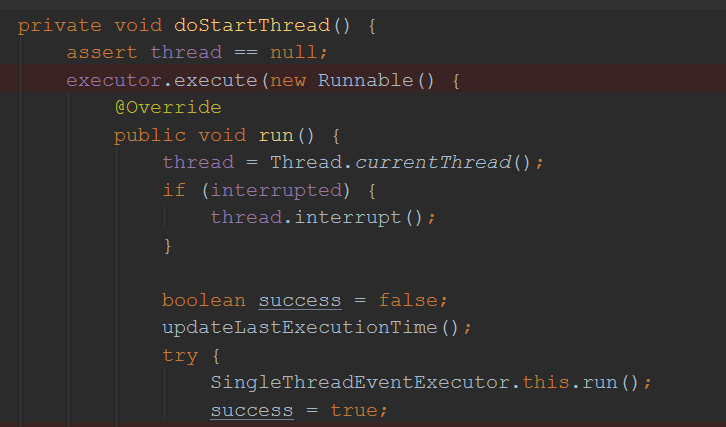前言
最近趁着跟老东家提离职之后、到新公司报道之前的这段空闲时期,着力研究了一番netty框架,对其有了一些浅薄的认识,后续的几篇文章会以netty为主,将近期所学记录一二,也争取能帮未对netty有过了解的园友对netty建立一个完整的认识。netty作为一个优秀的网络框架,值得为其花费一番时间。
netty的内容细究一下也有不少(虽然与Spring这种庞大的框架相比代码量少很多),本文作为netty系列的第一篇,决定先攀登一个高峰:讲一下netty的串行无锁化。这是netty的一个招牌特性,可以说理解了它,就掌握了netty的命门。开始正文之前,需要额外提醒一下,本文虽然是netty系列的第一篇,但是面向的对象是对netty有过一定了解的园友,如果是新人建议从第二篇【EventLoopGroup的初始化】开始看。
一、Talk is cheap,show me your code
先把netty的示例demo奉上,此处只要服务端构建的代码就可以了。
1 public class NettyDemo1 { 2 // netty服务端的一般性写法 3 public static void main(String[] args) { 4 EventLoopGroup boss = new NioEventLoopGroup(1); 5 EventLoopGroup worker = new NioEventLoopGroup(); 6 try { 7 ServerBootstrap bootstrap = new ServerBootstrap(); 8 bootstrap.group(boss, worker).channel(NioServerSocketChannel.class) 9 .option(ChannelOption.SO_BACKLOG, 100) 10 .childHandler(new ChannelInitializer<SocketChannel>() { 11 @Override 12 protected void initChannel(SocketChannel socketChannel) throws Exception { 13 ChannelPipeline pipeline = socketChannel.pipeline(); 14 pipeline.addLast(new StringDecoder()); 15 pipeline.addLast(new StringEncoder()); 16 pipeline.addLast(new NettyServerHandler()); 17 } 18 }); 19 ChannelFuture channelFuture = bootstrap.bind(90).sync(); 20 channelFuture.channel().closeFuture().sync(); 21 } catch (Exception e) { 22 e.printStackTrace(); 23 } finally { 24 boss.shutdownGracefully(); 25 worker.shutdownGracefully(); 26 } 27 } 28 }
从第4行到第18行,都是在进行初始化的属性赋值,第19行bind方法触发真正的串行无锁化处理逻辑。串行无锁化如何理解呢?望文生义即可,通过串行(即顺序执行),来达到即使没有锁也可以线程安全的效果。具体如何做到呢?且往下追踪bind方法。
二、源码追踪
1、initAndRegister方法
在AbstractBootstrap类中的doBind方法调用了下面的initAndRegister方法(该方法在netty中很重要,现在先记住混个眼熟),前两步虽然也很重要,但跟本文的主题关系不大,下面主要看第3步:
1 final ChannelFuture initAndRegister() { 2 Channel channel = null; 3 try { 4 channel = channelFactory.newChannel();// 1、实例化NioServerSocketChannel 5 init(channel);// 2、初始化该channel 6 } catch (Throwable t) { 7 // ...省略异常处理 8 } 9 ChannelFuture regFuture = config().group().register(channel);// 3、注册channel 10 if (regFuture.cause() != null) { 11 if (channel.isRegistered()) { 12 channel.close(); 13 } else { 14 channel.unsafe().closeForcibly(); 15 } 16 } 17 return regFuture; 18 }
第3步中,group()方法返回的是AbstractBootstrap中的group属性,该属性就是上面服务端demo中的boss变量。
2、boss.register(channel)方法
追踪进入MultithreadEventLoopGroup的register方法:
1 public ChannelFuture register(Channel channel) { 2 return next().register(channel); 3 }
next方法即从EventLoopGroup的EventExecutor数组中轮询取一个EventExecutor实例,即一个NioEventLoop对象,然后再调用NioEventLoop的register方法。
3、NioEventLoop.register(channel)方法
跟踪到SingleThreadEventLoop的register方法,如下,此处的promise.channel()返回值即之前的NioServerSocketChannel,它的unsafe()方法返回NioMessageUnsafe对象,所以此处最终调用的是NioMessageUnsafe的register方法。
1 public ChannelFuture register(final ChannelPromise promise) { 2 ObjectUtil.checkNotNull(promise, "promise"); 3 promise.channel().unsafe().register(this, promise); 4 return promise; 5 }
4、NioMessageUnsafe.register方法
该方法位于AbstractChannel的内部类AbstractUnsafe中(AbstractUnsafe是NioMessageUnsafe的父类):
1 public final void register(EventLoop eventLoop, final ChannelPromise promise) { 2 //... 省略异常校验 3 AbstractChannel.this.eventLoop = eventLoop; 4 5 if (eventLoop.inEventLoop()) {// 串行无锁化的第一个判断 6 register0(promise); 7 } else { 8 try { 9 eventLoop.execute(new Runnable() { 10 @Override 11 public void run() { 12 register0(promise); 13 } 14 }); 15 } catch (Throwable t) { 16 //... 省略异常处理 17 } 18 } 19 }
在eventLoop的父类SingleThreadEventExecutor中有一个成员变量thread,第5行代码用来判断这个thread是不是Thread.currentThread(),如果不是,则进入esle逻辑,执行eventLoop.execute方法。
5、eventLoop.execute方法
该方法位于SingleThreadEventExecutor中,主要做的事情有三步:1)、inEventLoop()方法判断当前线程是不是eventLoop中记录的线程;2)、addTask将任务放入队列中;3)、startThread()判断是否启动新线程。每步对应的代码在下面已经标出,比较简单。
执行到execute方法时,有三种情况:1)、eventLoop中记录的线程为null,即刚完成实例化;2)、eventLoop中记录的线程不为null,但不是当前线程;3)、eventLoop中记录的线程不为null,是当前线程(正常不会出现这种情况)。如果是第一种thread=null,则往队列中添加完任务后会进入startThread方法,在startThread方法中判断state属性是不是未启动,如果是则创建一个新的线程并通过cas将state置为已启动;如果是第二种情况thread!=null,往队列中添加任务后也会进入startThread方法,但由于state属性已经是已启动了,所以不会创建新的线程。至此,task中都添加了一个任务,且thread也有值了。
task中的任务是合适被执行的?且往下看。
1 public void execute(Runnable task) { 2 if (task == null) { 3 throw new NullPointerException("task"); 4 } 5 6 boolean inEventLoop = inEventLoop(); 7 addTask(task); // 将task任务放入队列中 8 if (!inEventLoop) { // 串行无锁化的第二次判断 9 startThread(); // 如果需要,会启动一个线程 重要*** 10 if (isShutdown()) { 11 boolean reject = false; 12 try { 13 if (removeTask(task)) { 14 reject = true; 15 } 16 } catch (UnsupportedOperationException e) { 17 } 18 if (reject) { 19 reject(); 20 } 21 } 22 } 23 24 if (!addTaskWakesUp && wakesUpForTask(task)) { 25 wakeup(inEventLoop); 26 } 27 }
6、doStartThread()方法
此方法位于SingleThreadEventExecutor类,executor即封装的线程池了,在run方法中完成了对thread的赋值,然后执行了当前类的run方法。

7、SingleThreadEventExecutor.run()方法
该方法的实现在NioEventLoop中,如下,多出对 runAllTasks()方法进行调用,就是在这个方法中完成的对队列中任务的执行,直接调用的task.run方法,即单线程串行消费队列。
1 protected void run() { 2 for (;;) { 3 try { 4 try { 5 switch (selectStrategy.calculateStrategy(selectNowSupplier, hasTasks())) { 6 case SelectStrategy.CONTINUE: 7 continue; 8 case SelectStrategy.BUSY_WAIT: 9 case SelectStrategy.SELECT: 10 select(wakenUp.getAndSet(false)); 11 if (wakenUp.get()) { 12 selector.wakeup(); 13 } 14 // fall through 15 default: 16 } 17 } catch (IOException e) { 18 // ...异常处理省略 19 continue; 20 } 21 22 cancelledKeys = 0; 23 needsToSelectAgain = false; 24 final int ioRatio = this.ioRatio; 25 if (ioRatio == 100) { 26 try { 27 processSelectedKeys(); 28 } finally { 29 // Ensure we always run tasks. 30 runAllTasks(); 31 } 32 } else { 33 final long ioStartTime = System.nanoTime(); 34 try { 35 processSelectedKeys(); 36 } finally { 37 // Ensure we always run tasks. 38 final long ioTime = System.nanoTime() - ioStartTime; 39 runAllTasks(ioTime * (100 - ioRatio) / ioRatio); 40 } 41 } 42 } catch (Throwable t) { 43 handleLoopException(t); 44 } 45 // ...省略无关代码 46 } 47 }
三、小结
上面是过了一遍netty串行无锁化的流程,下面对整个流程做一下总结。
netty串行无锁化的实现,是借助了SingleThreadEventExecutor中的Thread thread、int state和Queue<Runnable> taskQueue这三个成员变量。state变量用于判断当前EventExecutor是否启动(未启动则通过线程池创建一个启动线程并赋值给thread),thread变量用来判断当前线程是不是启动线程(通过inEventLoop方法实现),taskQueue用于存放待启动线程串行执行的任务。在NioEventLoop的run方法中,每一次循环都遍历一遍taskQueue执行里面的任务。
可以知道,一个NioEventLoop对应一个串行执行的启动线程,Reactor主线程对应的是boss中的一个NioEventLoop,负责串行执行客户端连接事件,Reactor子线程是有客户端接入事件后由主线程启用的,对应worker中的一个NioEventLoop,负责串行执行客户端读写时间。
至此,串行无锁化的内容就结束了,后面将从EventLoopGroup的初始化开始,一步步从零开始拆解netty的作用原理,敬请期待!
原创不易,若有问题,还请批评指正,感谢!